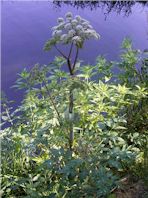 |
The wild Angelica grows commonly throughout England in wet places as an umbelliferous plant, with a tall hollow stem, out of which boys like to make pipes. It is purple, furrowed, and downy, bearing white flowers tinged with pink. But the herb is not useful as a simple until cultivated in our gardens, the larger variety being chosen for this purpose, and bearing the name Archangelica.
"Angelica, the happy counterbane,
Sent down from heaven by some celestial scout,
As well its name and nature both avow't." |
It came to this country from northern latitudes in 1568. The aromatic stems are grown abundantly near London in moist fields for the use of confectioners. These stems, when candied, are sold as a favorite sweetmeat. They are grateful to the feeble stomach, and will relieve flatulence promptly. The roots of the garden Angelica contain plentifully a peculiar resin called "angelicin," which is stimulating to the lungs, and to the skin: they
smell pleasantly of musk, being an excellent tonic and carminative. An infusion of the plant may be made by pouring a pint of boiling water on an ounce of the bruised root, and two tablespoonfuls of this should be given three or four times in the day; or the powdered root may be administered in doses of from ten to thirty grains. The infusion will relieve flatulent stomach-ache, and will promote menstruation if retarded. It is also of use
as a stimulating bronchial tonic in the catarrh of aged and feeble persons. Angelica, taken in either medicinal form, is said to cause a disgust for spirituous liquors. In high Dutch it is named the root of the Holy Ghost. The fruit is employed for flavoring some cordials, notably Chartreuse. If an incision
s made in the bark of the stems, and the crown of the root, at the commencement of spring, a resinous gum exudes with a special aromatic flavor as of musk or benzoin, for either of which it can be substituted. Gerard says: "If you do but take a piece of the root, and hold it in your mouth, or chew the same between your teeth, it doth most certainly drive away pestilent aire." Icelanders eat both the stem and the roots raw with butter. These
parts of the plant, if wounded, yield a yellow juice which becomes, when dried, a valuable medicine beneficial in chronic rheumatism and gout. Some have said the Archangelica was revealed in a dream by an angel to cure the plague; others aver that it blooms on the day of Michael the Archangel (May 8th, old style), and is therefore a preservative against evil spirits and witchcraft.
Herb Simples
The Primitive Simplers presented here show the way of life in other generations, it is not suggested or recommended trying them yourself. |


